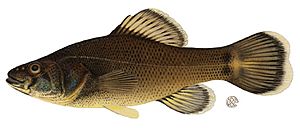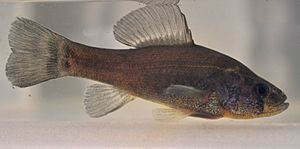Pirate perch facts for kids
Quick facts for kids Pirate perch |
|
|---|---|
 |
|
 |
|
| Conservation status | |
| Scientific classification |
The pirate perch (Aphredoderus sayanus) is a freshwater fish. It lives in rivers and streams along the eastern coast of the United States and in the Mississippi River area. These fish usually live alone. They are active at night and eat other small creatures.
Pirate perch like clear, warm water that doesn't flow too fast. They often stay near the bottom. They eat things like mosquito larvae, tiny shrimp, worms, and even small fish.
This fish is special because it's the only one in its family, Aphredoderidae. Its scientific name, sayanus, honors a scientist named Thomas Say. The fish got its common name, "pirate perch," because it was seen eating only other fish.
Contents
What Does the Pirate Perch Look Like?
This small fish can grow up to about 14 centimeters (5.5 inches) long. It is usually dark brown. Sometimes, it has a darker stripe near its tail.
A very unique thing about the pirate perch is where its cloaca is located. The cloaca is an opening used for waste and reproduction. For the pirate perch, it's found under its head, which is unusual for a fish!
The pirate perch might also be the only animal known to use a special kind of chemical camouflage. This helps it hide from many different animals that might want to eat it.
Where Do Pirate Perch Live?
Pirate perch are freshwater fish. They live in places where the water temperature is usually between 5 and 26 degrees Celsius (41 to 79 degrees Fahrenheit). You can find them mostly in central and eastern North America.
They live in rivers along the Atlantic and Gulf coasts. They are also found in the Mississippi Valley and some parts of the eastern Great Lakes Basin.
Sadly, pirate perch used to live in Pennsylvania. But they are no longer there because of cities growing and changing the environment. Building dams and more cities can make their habitat smaller. This could cause them to disappear from other areas too.
How Do Pirate Perch Live?
These fish like to hide in places with lots of plants or woody debris. They also hide under riverbanks in tangled roots. Bigger pirate perch often choose more complex hiding spots than smaller ones.
They gather in these hidden areas to stay safe from animals that might eat them. These predators include birds, otters, and mink. Pirate perch hunt for food at night. Their diet includes mosquito larvae, small shrimp, worms, and the larvae of dragonflies and stoneflies.
Pirate Perch Life Cycle and Reproduction
Pirate perch usually breed from October to December in Florida. In Louisiana, they can start breeding as early as February. Most breeding happens from early April to May, depending on how far north they live.
When it's time to breed, they use underwater root masses as a safe place for their eggs. Female fish have been seen pushing their heads into these root masses and releasing their eggs. Then, male fish come to the same spots and fertilize the eggs.
A female can lay between 100 and 400 eggs. The number of eggs depends on her size. Pirate perch can start having babies after one year. They can live up to four years in the wild.
For a long time, scientists didn't fully understand how pirate perch laid their eggs. It was hard to watch them in their natural habitat. At first, some thought the fish might carry their eggs in their gill chambers. But it was found that they don't do this.
Instead, they lay their eggs in underwater roots. However, they do have a unique way of laying eggs. The eggs go from the special opening (cloaca) to the gill chamber. Then, the fish spits the eggs out through its mouth into the roots!
Protecting the Pirate Perch
The Iowa Department of Natural Resources says that siltation is a big threat to pirate perch habitats. Siltation happens when too much dirt and mud build up in the water. This can happen because of poor land management upstream.
Since these fish like slow-moving water, changes upstream can affect them. Things like dams or drainage projects can change how fast the water flows. This can make their habitat unsuitable.
Water pollution from farms and cities can also harm these fish. Ohio has shown some interest in protecting the pirate perch. This is because the fish only lives in a small area in the northwestern part of that state. However, not many other places have shown much concern for this species.
See also
 In Spanish: Perca pirata para niños
In Spanish: Perca pirata para niños


